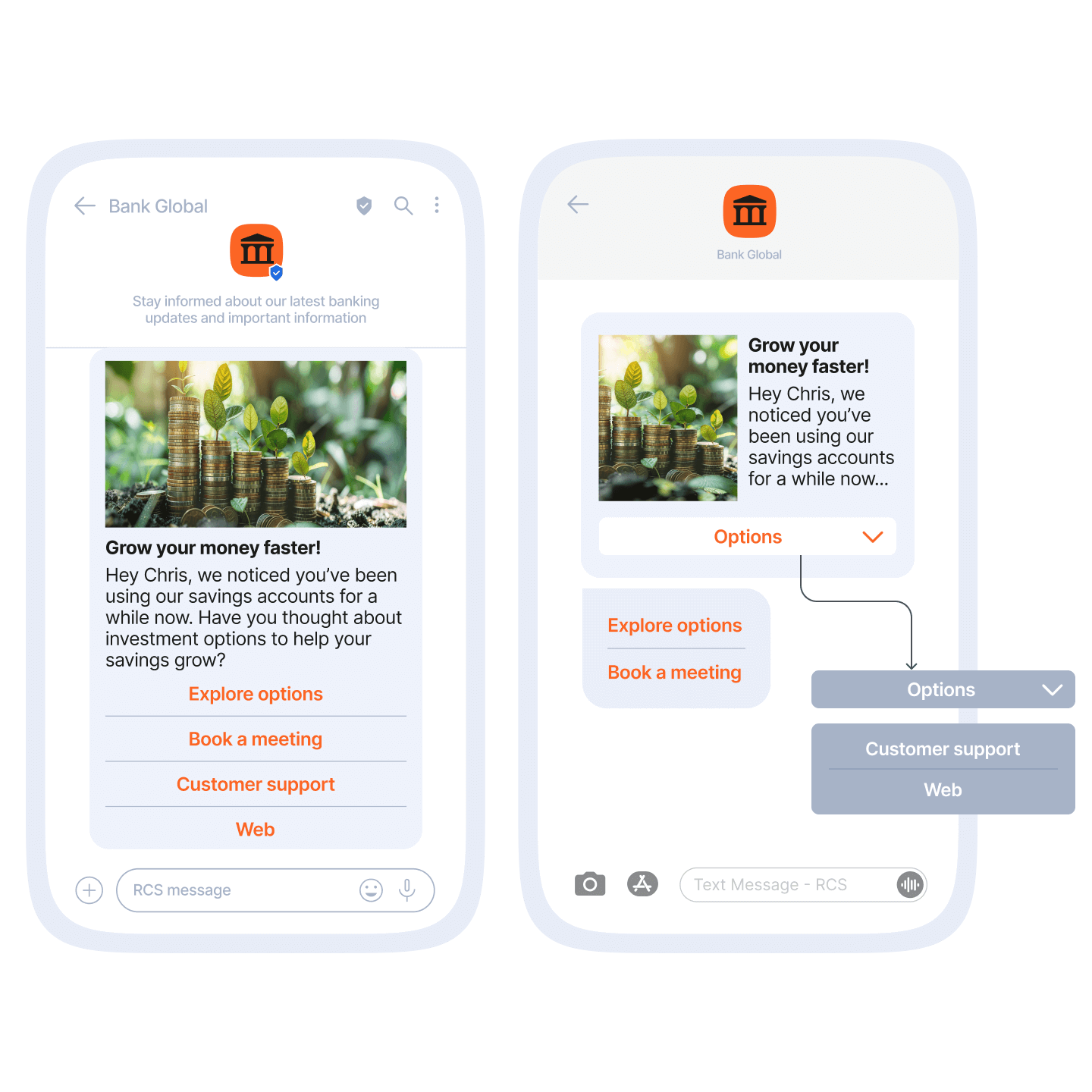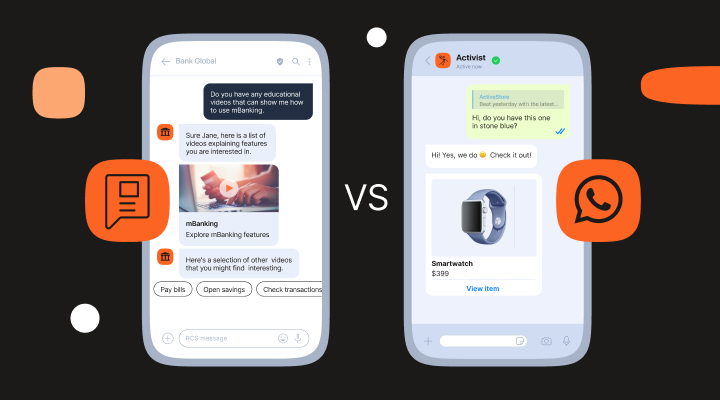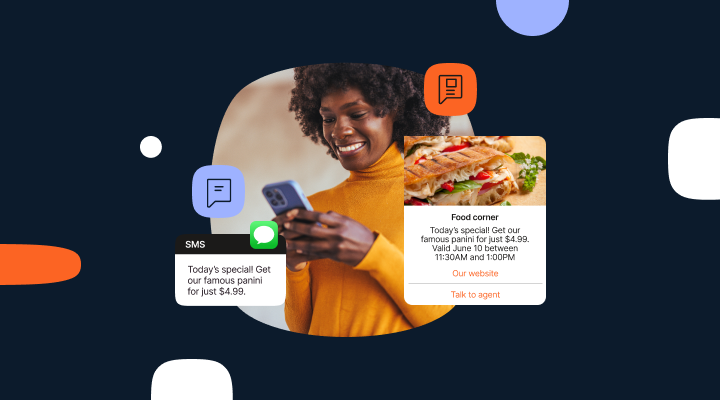What is RCS Messaging? Rich Communication Services explained
Rich Communication Services (RCS) is the next evolution of SMS, offering interactive features like high-quality media sharing, read receipts, and typing indicators—all from your default messaging app.
RCS: what it means
RCS stands for Rich Communication Services. Rich Communication Services (RCS) is changing mobile messaging by offering a modern, feature-rich alternative to traditional SMS messages and MMS. As the next-generation messaging service, RCS introduces interactive, internet-based features to the default texting apps on mobile phones, blending the simplicity of text messaging with the power of popular chat apps like WhatsApp and iMessage.

Features of RCS
Unlike SMS, which is text-only with a 160 character limit, and MMS, which supports only basic media sharing, RCS enables:
- High-resolution image and video sharing: One of the most significant benefits of RCS is its ability to support rich media. Users can send high-resolution images, videos, and audio messages without the limitations of traditional SMS. This allows for more engaging conversations and a better overall experience.
- Read receipts and typing indicators: RCS provides features like read receipts and typing indicators, which let users know when their messages have been seen and when the other person is typing. This introduces a level of engagement that SMS couldn’t provide before, enhancing the dynamism and connection in conversations.
- Advanced group messaging: RCS supports larger group chats, allowing users to communicate with multiple people at once. This is particularly useful for coordinating events, sharing updates, or simply staying in touch with friends and family.
- Branded content for businesses: For businesses, RCS Business Messaging opens new avenues for customer engagement. Companies can send branded messages, including images, carousels, and quick reply buttons, directly to consumers. This not only enhances the customer experience but also allows businesses to provide timely information, such as order updates or promotional offers.
- Security features (optional end-to-end encryption): RCS also includes improved security features compared to SMS. Messages are encrypted, providing a safer environment for users to communicate sensitive information.
- Seamless integration: With RCS, users can easily integrate their messaging experience with other apps and services. This means you can book appointments, make reservations, or even shop directly through a chat interface, all without leaving the messaging app.
These features require internet connectivity (either mobile data or Wi-Fi) and are available right within your existing texting interface, often via RCS chats in Google Messages. RCS makes it easy to send messages that are visually rich, interactive, and more informative—all linked to your regular phone number.

In summary: Why RCS Messaging matters in 2025
- Over 1.2 billion monthly active users in 60+ countries, set to surpass 2 billion by end of 2025
- Significantly higher open rate (72%) than typical email open rates (20–30%) and trackable in a way that SMS open rates aren’t
- 35x more likely to be read than email, with 90% of messages opened within 15 minutes
- Market projected to grow from $10.14 billion in 2025 to $34.39 billion by 2029
- AI, payments, and encryption are making RCS the most advanced, secure, and engaging messaging channel available
RCS vs SMS vs MMS: Key differences
| Feature | SMS | MMS | RCS |
|---|---|---|---|
| Max character limit | 160 | 160 | Unlimited |
| Media sharing | None | Basic | High-resolution photos & videos |
| Read receipts | No | No | Yes |
| Group messaging | Limited | Limited | Advanced |
| Internet required | No | No | Yes |
| Encryption | No | No | Available (varies) |
*Note: RCS requires an internet connection but delivers a far richer messaging experience than SMS or MMS.
RCS on Android vs iPhone (2025 update)
In 2024, Apple adopted RCS in iOS 18, enabling iPhone users to finally engage in rich, cross-platform messaging with Android users. On Android, RCS messages on Android devices are typically enabled via the Google Messages app or supported carrier apps.
When you see “RCS enabled,” it means that both sender and recipient are using compatible cellular networks, apps, and have an internet connection, allowing RCS features to work seamlessly.

Top benefits of RCS for businesses and consumers
RCS offers numerous advantages for both businesses and consumers, let’s explore.
For businesses
- Branded messaging: Add logos, verified profiles, and brand colors
- Rich media messaging: Share videos, GIFs, and interactive product carousels
- Interactive CTAs: Drive purchases, bookings, or customer service via buttons
- Analytics: Gain real-time data like typing indicators read receipts and interaction rates
- Enhanced delivery: More consistent message delivery than SMS
For consumers
- Media-rich communication: HD photo and video sharing
- Read & typing indicators: Know when someone sees your message or is replying
- Improved group chats: Organize conversations with better tools
- Optional encryption: Stay private and secure with supported providers
- Cross-platform compatibility: Smooth messaging between Android and iPhone
In summary, RCS is transforming the way we communicate, bridging the gap between different platforms and enhancing the overall messaging experience. As more users and businesses adopt this technology, we can expect to see even more innovative features and applications in the future.
The growing significance of RCS Messaging (2025 insights)
- User base: As of mid-2025 RCS has over 1.2 billion monthly active users globally and is expected to hit 2 billion monthly active users by late 2025 thanks to Apple and Android’s wide reach
- Message volume: Projected to soar from 1.5 trillion in 2024 to 6 trillion by 2029
- Business messaging growth: 50 billion RCS messages expected in 2025, with revenue reaching $4.2 billion by 2029
- Market forecast: From £1.8 billion in 2024 to £8.7 billion by 2029—a 370% increase
- Engagement: 72% open rate and trackable in a way that SMS open rates aren’t
- Consumer preferences: 75% expect businesses to use next-gen tools like RCS; 68% prefer brands that offer modern, convenient messaging services
New developments
- AI integration: In 2025, AI is deeply integrated into RCS, powering chatbots, personalized recommendations, and smart replies—helping businesses scale customer service and automate marketing with unprecedented efficiency.
- Seamless payments: RCS now supports integrated payment solutions, allowing customers to pay for products and services directly within their chat thread, streamlining the purchase process and boosting conversion rates.
- Dual SIM support: Google Messages now supports dual SIM RCS, making it easier for international travelers and users with multiple numbers to stay connected.
- Enhanced read receipts: Read receipts have been redesigned for clarity, and users can now see detailed message status and encryption info with a swipe.
- End-to-end encryption: Apple and Google are working with the GSMA to bring end-to-end encryption to RCS Universal Profile, ensuring private, secure communication across platforms.
- Rapid retail adoption: Retailers are leveraging RCS to send interactive catalogs, personalized offers, and real-time order updates, transforming the customer experience and driving sales.

Troubleshooting and how-to tips
If RCS isn’t working as expected, try these quick troubleshooting steps to get back on track.
- Open your messaging app and check RCS chats in Google Messages settings
- Ensure mobile data or Wi-Fi is enabled
- Keep your messaging app up to date
- Clear app cache if you experience delays
- Contact your cellular network provider for compatibility issues
What’s next for RCS?
With universal adoption now a reality, thanks to Apple’s embrace of RCS in iOS 18, the future is bright. Upcoming features include:
- Full RCS Universal Profile compliance across carriers and devices
- Enhanced encryption standards
- Built-in payment solutions
- AI-powered smart replies and personalized messaging flows
RCS offers a unified communication solution that merges the ease of texting with the interactivity of chat apps. Its rapid adoption, advanced capabilities, and business potential make it a key part of the future of mobile messaging.
Common questions about RCS Messaging
It refers to RCS features like multimedia support, interactive messages, and real-time feedback in messaging.
RCS and SMS differ in capability—RCS is media-rich and internet-powered, whereas SMS is text-only and offline.
Yes, as of iOS 18, RCS is supported natively on iPhones.
In Google Messages, go to Settings > Chat Features and toggle the feature on or off.
Your device is using RCS to send messages when available, offering better quality and interactivity.
This can happen if the recipient’s device doesn’t support RCS, there’s no internet, or if fallback settings are triggered by the messaging app.
RCS is often confused with unrelated terms like RCA, RSC, or RMS. These acronyms refer to different technologies and have no relation to Rich Communication Services. Similarly, RCS is distinct from OTT messaging apps like WhatsApp or Telegram, which operate over the internet but outside the native SMS inbox.
Infobip has a history of helping brands benefit from using RCS Business Messaging:

Telekom Deutschland: Elevating customer engagement with RCS Business Messaging.
- Operators.
- RCS.
- Telco.
- Inspiration.

Virgin Mobile (now Virgin Media O2): Increased engagement and phone upgrades through rich, interactive RCS messages.
Discover how Virgin Mobile (now Virgin Media O2) increased their customer lifetime value with a conversational marketing campaign on RCS.
- Marketing.
- RCS.
- Telco.
- Inspiration.

Niva Bupa: Increasing customer acquisition and ROI with a rich, omnichannel marketing strategy.
Find out how India’s leading health insurance company used RCS Business Messaging alongside other popular channels to re-engage customers who abandon their website, leading to higher returns on investment and retention.
- Customer Service.
- RCS.
- Financial Services.
- Inspiration.

Club Comex: Campaign Revenue Growth of 115% with RCS Business Messaging.
Club Comex increased their revenue by 115% using RCS (Rich Communication Services) and its range of branded, rich, content. Learn how!
- Marketing.
- RCS.
- Retail.
Continue reading about RCS:

RCS vs WhatsApp in 2025: Choosing the right channel.
We compare RCS with WhatsApp in terms of features, price, security, and all the other factors that need to be considered when selecting a channel for exploring a more conversational style of B2C interaction.
- RCS.
- WhatsApp Business.
- Awareness.

The future of conversational messaging with RCS: A look ahead with BT.
Dive into the world of RCS and conversational messaging in this exclusive interview with BT. Learn how our partnership is shaping the future of customer engagement.
- Blog.
- Spotlight.
- Partnership.
- RCS.
- Telco.

RCS Business Messaging for secure banking.
Deep dive into the world of banking via RCS Business Messaging and learn about the benefits, use cases, and how to get started.
- Blog.
- RCS.
- Financial Services.
- Awareness.

Automated conversations at scale with RCS and Vertex AI.
Find out how building chatbots for the RCS channel that are powered by Google's Vertex AI can deliver some exceptional use cases.
- Blog.
- AI chatbots.
- conversational commerce.
- Generative AI.
- Conversational experience.
- RCS.
- Awareness.

RCS Business Messaging guide with examples.
Discover the power of RCS Business Messaging to build stronger relationships and drive impressive results.
- RCS.
- Best Practices.








